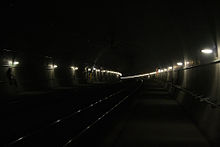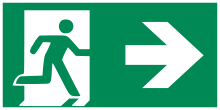emergency lighting

The emergency or safety lighting is a lighting that in case of failure of the power supply is effectively the general electrical lighting or held. It is divided into emergency lighting and replacement lighting.
General
In the event of a power failure, orientation in buildings is often very difficult for non-residents. A second lighting system with ( fire-retardant ) cabling or a safety power source, which is independent of the general supply, enables people to leave the building safely and quickly.
In the case of emergency lighting, a distinction is made between safety lighting and replacement lighting. When it comes to safety lighting , a distinction can be made between safety lighting for escape routes , anti-panic lighting and safety lighting for workplaces with particular hazards .
Replacement lighting
The replacement lighting ensures that necessary work can be continued for a certain time in the event of a power failure, provided there is no risk to employees. Replacement lighting is used, for example, in surveillance systems, command rooms for security organs, industrial systems or in operating rooms in hospitals.
Security lighting

The safety lighting enables people to safely leave a room, a building section and / or a building in the event of danger. Depending on the requirements or workplace, a dangerous workflow can also be completed beforehand. When it comes to safety lighting, a distinction is made between safety lighting for escape routes, safety lighting for workplaces with particular hazards and anti-panic lighting. The most important requirements according to DIN EN 1838 and the technical rules for workplaces ASR A3.4 / 3 are:
- Uniformity: The ratio of the greatest to the smallest illuminance may not exceed 40: 1.
- The emergency lighting must have achieved 100 percent light output within 15 seconds of failure of the general lighting.
- At least 1 lux horizontal illuminance on the central axis of the escape and rescue route
- At least color rendering index R a 40 of the light sources
Escape sign luminaires with green and white pictograms in accordance with EN ISO 7010 , i.e. stylized people with an arrow pointing in the direction of escape, are installed as part of the emergency lighting and are also part of a building's safety guidance systems. A special feature applies to railway, tram and subway tunnels: there the emergency exits are marked with escape signs backlit in blue in order to avoid confusion with green railway signals.
Safety lighting on escape and rescue routes
The safety lighting shows the way to the exit, illuminates the escape and rescue route and enables the detection of obstacles and level differences such as stairs. It also identifies first aid stations, fire-fighting (e.g. fire extinguishers ) and reporting systems.
Workplaces and workplaces with particular risk
Employers are obliged to protect their employees and must prepare a risk assessment. This is used to determine whether all employees can safely leave their workplaces if the lighting fails.
Workplaces with particular risk include construction sites, laboratories, workplaces near hot baths or casting pits, electrical operating rooms and control facilities. Safety lighting of at least 15 lux after 0.5 seconds at the latest is required here. The uniformity of the lighting in these work areas is less than 10: 1.
Anti-panic lighting
The anti-panic lighting is intended to prevent mass panic in the dark in meeting places . It ensures sufficient visual conditions so that escape and rescue routes can be reached safely. Anti-panic lighting must be installed if the escape routes are not clearly defined in large halls or the entire area can be used as an escape route. It is also necessary in conference rooms over 60 square meters in size without designated escape routes and in elevators.
Power supply
The power supply comes from a backup power source. These can be battery systems or power generating sets. The safety lighting can be operated in permanent switching (constant light operation) or in standby mode (switching on the lights in the event of a power failure ). There is also the option of switching emergency lights on and off. Electronic modules are connected upstream, so that the luminaires can then either be controlled using local buttons or via a data bus. In the event of a power failure in the general supply, these lights are then supplied by the safety power source. The operator is legally and normatively obliged to regularly check, maintain and repair the safety lighting.
Norms
Standards , ordinances from building law and occupational safety regulate the requirements for emergency and safety lighting.
Lighting requirements
- ISO 30061; CIE S 020 (2007-11) emergency lighting
- DIN EN 1838: 2013-10 Applied lighting technology - Emergency lighting
- DIN EN 13032-3 (2007-12) Light and lighting - Measurement and presentation of photometric data from lamps and luminaires, Part 3: Presentation of data for emergency lighting in workplaces
- DIN 5035-6 (2006-11) Lighting with artificial light - Part 6: Measurement and evaluation
- DIN 4844-1 (2012-06) Graphic symbols - Safety colors and safety signs - Part 1: Recognition distances and color and photometric requirements
- DIN ISO 3864-1 (2012-06) Graphic symbols - Safety colors and safety signs - Part 1: Design principles for safety signs and safety markings
- DIN EN ISO 7010 (2012-10) Graphic symbols - Safety colors and safety signs - Registered safety signs
Electrotechnical requirements
- DIN EN 50172 (2005-01) Safety lighting systems (VDE 0108 part 100)
- DIN V VDE V 0108-100 (2010-08) Emergency lighting systems (preliminary standard VDE V 0108-100) Note: The application of this preliminary standard is recommended by UK 221.3 of the DKE.
- DIN VDE 0100-710 (2012-10) Construction of low-voltage systems - Requirements for production facilities, rooms and special types of systems - Part 710: Areas used for medical purposes
- DIN VDE 0100-560 (2013-10) Erection of low-voltage systems - Part 5-56: Selection and erection of electrical equipment - Equipment for safety purposes
- DIN EN 60598-1 (2015-10) Luminaires - General requirements and tests (VDE 0711 Part 1))
- DIN EN 60598-2-22 (2015-06) Luminaires - Part 2-22: Special requirements - Luminaires for emergency lighting (VDE 0711 Part 2-22) (IEC 60598-2-22)
- DIN EN 50171 (2001-11) Central power supply systems
- DIN EN 50272-2 (2001-12) Safety requirements for batteries and battery systems
- DIN EN 62034 (2013-02) Automatic test systems for battery-operated safety lighting for escape routes (IEC 62034: 2006)
Osh
- ArbStättV (2004-08) Workplace Ordinance
- ASR A1.3 (2013-02) Technical rule for workplaces: Safety and health protection signs
- ASR A2.3 (2007-08, amended 2014) Technical rule for workplaces: escape routes, emergency exits, escape and rescue plan
- ASR A3.4 / 3 (2009-05, amended 2014) Technical rule for workplaces: safety lighting, optical safety guidance systems
Building law
- MBO (2012-09) sample building regulations
- MVStättV (2014-07) Model Ordinance on Places of Assembly
- MGarVO (2008-05) Model Garage Ordinance
- MIndBauRL (2014-02) Sample industrial building guidelines
- MBeVO (2014-05) Sample Accommodation Ordinance
- MSchulbauR (2009-04) Model school building guidelines
- MHHR (2008-04) model high-rise guideline
- MLAR (2005-11) Model line system guideline
- MVkVO (2014-07) sample sales outlet ordinance
- M-EltBauVO (2009-01) Model ordinance on the construction of operating rooms for electrical systems
literature
- Hans R. Ris: Lighting technology for practitioners. 2nd Edition. VDE-Verlag, Berlin / Offenbach 1997, ISBN 3-8007-2163-5 .
- Reinald Skiba : Taschenbuch Betriebliche Sicherheitstechnik. 3. Edition. Erich Schmidt Verlag, Regensburg / Münster 1991, ISBN 3-503-02943-5 .
- Bruno Weis, Hans Finke: Emergency and safety lighting. 2nd Edition. Hüthig & Pflaum Verlag, Heidelberg 2017, ISBN 978-3-8101-0428-1 .
Web links
- Normative regulation for the installation of safety lighting systems
- Emergency lighting and safety lighting: How standards and regulations interact
- Zentralverband Elektrotechnik- und Elektronikindustrie e. V.
- licht.wissen 10 - Emergency lighting, safety lighting (PDF file; 4.8 MB).
- licht.forum 56 - Safety lighting for workplaces (PDF file; 1 MB).
- licht.forum 57 - Optical safety guidance systems (PDF file; 567 kB).
Individual evidence
- ↑ licht.wissen 01: Emergency lighting, safety lighting . licht.de, Frankfurt 2016, ISBN 978-3-945220-12-2 , p. 20.
